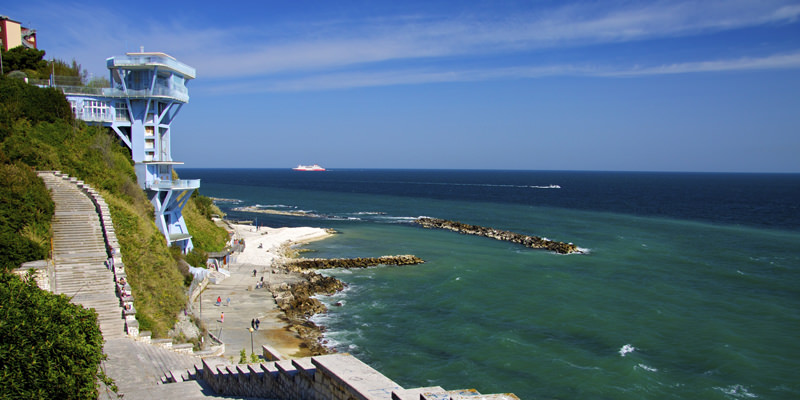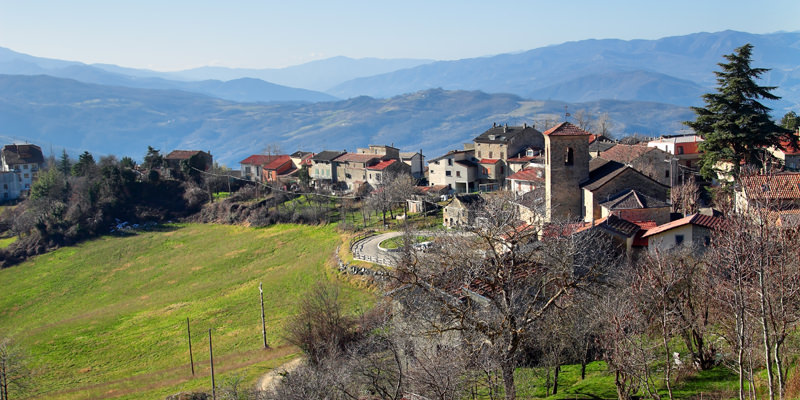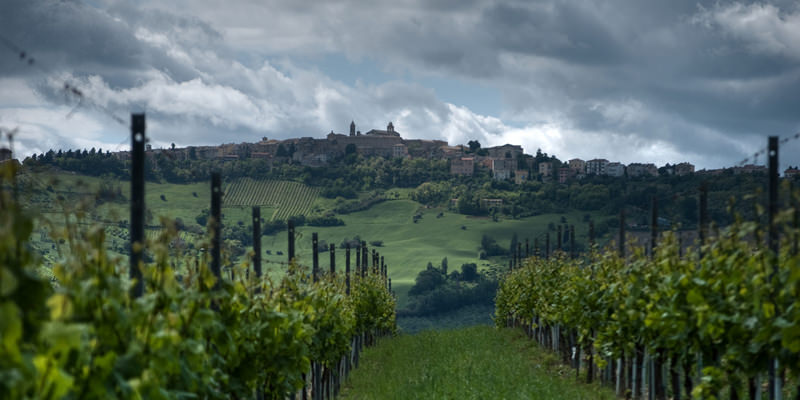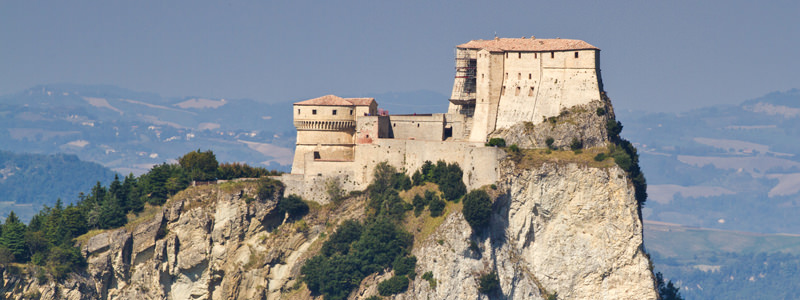Welcome to the edge – the eastern edge of Central Italy, that is. This is the region of Le Marche (Lay mary-Kay) and it is a wine region to be taken seriously, not just because it birthed the founder of one of America’s most famous wine dynasties, Cesare Mondavi. Although sometimes overshadowed by it’s better-known neighbors – Abruzzo to the south, and Umbria and Tuscany to the West – this region produces stellar wine.
The name Le Marche is quite unique, and originates from the medieval communes that used to make up the area. The regional capital, Ancona, was a major port town, first for the Roman Empire and subsequently for the other cultures that occupied it after the Empire’s fall. Now, Le Marche is known for its beautiful coastline, which attracts thousands of tourists a year to the white sandy beaches, towering cliffs and clear blue waters.
Regarding wine, though, it is farther inland where things get really interesting. The western border is formed by a swath of the Apennine Mountain Range, and the Adriatic lies to the East, forming a diverse offering of various terroir with calcareous and limestone soil. Whereas the southern part of the region has what is called a Mediterranean/maritime climate (land influenced by the sea) the northern half is characterized by a much more continental climate (land influenced by the land itself and far from an ocean). Like many Italian regions there are a plethora of DOC’s (15) and DOCG (5), but only a few make the cut on the American market. The number is growing, but for our purposes let’s talk about the region’s more well known wines to get you started on enjoying the amazing wine made here.
Rosso Conero DOC
 Let’s begin at the coast and work our way in, shall we? The Rosso Conero DOC (awarded in 1968) is a wine region situated just south of the Le Marche capital of Ancona, with vineyards on and around Monte Conero, an Apennine mountain at the edge of the sea. Sounds very storybook, doesn’t it? Well, it is! It’s like a Game Of Thrones filming location. The Montepulciano grape is the focus in this continental climate, and grows in mineral heavy soils of chalky limestone and clay. The results are rich, powerful wines dark in color with significant aromas of black cherries and herbs wrapped up in highly structured tannins. The wines must be at least 85% Montepulciano and can have a minimum of Sangiovese and other permitted varieties to ramp up the acidity. The wines also have quite a wide price range, starting at around $10 and going as a high as $80 (There is also a Rosso Conero Riserva with a DOCG designation — awarded in 2004 — that requires an extra year of aging before release). For food, it’s all about pork dishes and pecorino (sheep’s milk) cheese, one of the most popular styles in the region.
Let’s begin at the coast and work our way in, shall we? The Rosso Conero DOC (awarded in 1968) is a wine region situated just south of the Le Marche capital of Ancona, with vineyards on and around Monte Conero, an Apennine mountain at the edge of the sea. Sounds very storybook, doesn’t it? Well, it is! It’s like a Game Of Thrones filming location. The Montepulciano grape is the focus in this continental climate, and grows in mineral heavy soils of chalky limestone and clay. The results are rich, powerful wines dark in color with significant aromas of black cherries and herbs wrapped up in highly structured tannins. The wines must be at least 85% Montepulciano and can have a minimum of Sangiovese and other permitted varieties to ramp up the acidity. The wines also have quite a wide price range, starting at around $10 and going as a high as $80 (There is also a Rosso Conero Riserva with a DOCG designation — awarded in 2004 — that requires an extra year of aging before release). For food, it’s all about pork dishes and pecorino (sheep’s milk) cheese, one of the most popular styles in the region.
Rosso Piceno DOC
 To the south of Conero, and taking up a much larger area is the Rosso Piceno DOC (also awarded in 1968). The vines here live in the hilly terrain at the foot of the Apennines. While Conero claims a continental climate, the wine region of Piceno, with its lower elevation, has more of a direct relationship with the sea, giving it a Mediterranean atmosphere. This results in a higher acidity in the wine due to the influence of wind currents from the coast and the abundance of calcareous soils. Because of this, the sometimes brutish Montepulciano takes side stage to the more vibrant Sangiovese. It allows for a little more creativity, as seen in the DOC regulations. The wines here must be between 35% and 85% Sangiovese and 15% to 50% Montepulciano. They also allow a maximum of 15 % of other varieties including some white grapes. These wines still have that rich dark color but are softer than the Conero wines, while remaining full bodied but with more vibrant cherry notes and sweet tannins. This is a great burger wine and will also hang out with the pairings mentioned above as a lighter alternative. The price range is very similar to that of Rosso Conero.
To the south of Conero, and taking up a much larger area is the Rosso Piceno DOC (also awarded in 1968). The vines here live in the hilly terrain at the foot of the Apennines. While Conero claims a continental climate, the wine region of Piceno, with its lower elevation, has more of a direct relationship with the sea, giving it a Mediterranean atmosphere. This results in a higher acidity in the wine due to the influence of wind currents from the coast and the abundance of calcareous soils. Because of this, the sometimes brutish Montepulciano takes side stage to the more vibrant Sangiovese. It allows for a little more creativity, as seen in the DOC regulations. The wines here must be between 35% and 85% Sangiovese and 15% to 50% Montepulciano. They also allow a maximum of 15 % of other varieties including some white grapes. These wines still have that rich dark color but are softer than the Conero wines, while remaining full bodied but with more vibrant cherry notes and sweet tannins. This is a great burger wine and will also hang out with the pairings mentioned above as a lighter alternative. The price range is very similar to that of Rosso Conero.
Verdicchio
 The ancient Verdicchio (little green one) grape is truly the pride and joy of the Le Marche region. Just in from Ancona and west of the Rosso Conero DOC is the large Verdicchio Castelli Di Jesi DOC. Planted in low-lying hills of limestone, clay and calcareous soils and influenced not only by the Adriatic but it’s two rivers, the Cesano and the Esino, this is one of the windiest areas of Le Marche and an ideal location for the grape. This region sees many different styles, from dry to sweet to sparkling, and has superiore and classico designations. But if you are just getting to know Verdicchio, go for the crisp and round straw colored green tinged affordable $10-$20 version with notes of green apple and a slight hint of bitter almond on the finish, which is a perfect pairing for any and all fish-based dishes.
The ancient Verdicchio (little green one) grape is truly the pride and joy of the Le Marche region. Just in from Ancona and west of the Rosso Conero DOC is the large Verdicchio Castelli Di Jesi DOC. Planted in low-lying hills of limestone, clay and calcareous soils and influenced not only by the Adriatic but it’s two rivers, the Cesano and the Esino, this is one of the windiest areas of Le Marche and an ideal location for the grape. This region sees many different styles, from dry to sweet to sparkling, and has superiore and classico designations. But if you are just getting to know Verdicchio, go for the crisp and round straw colored green tinged affordable $10-$20 version with notes of green apple and a slight hint of bitter almond on the finish, which is a perfect pairing for any and all fish-based dishes.
As you plan your next vacation keep in mind the beauty of this eastern central region and sip the wines that will take you there as you look up flights. There are a few other great wines to speak of from this region, which I would need to dedicate an entire post to, but until then these are the ones to look for as a primer to Le Marche.

